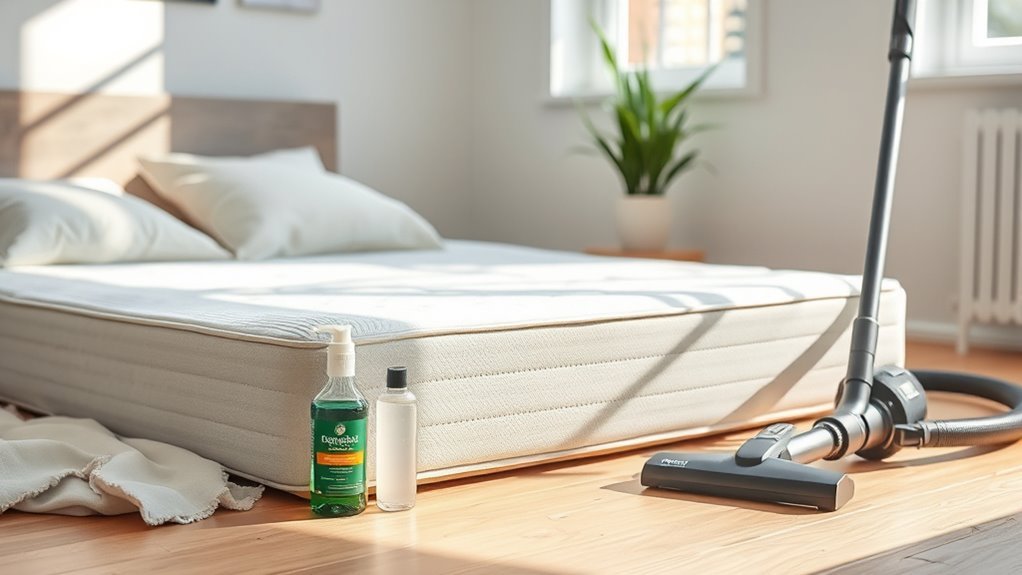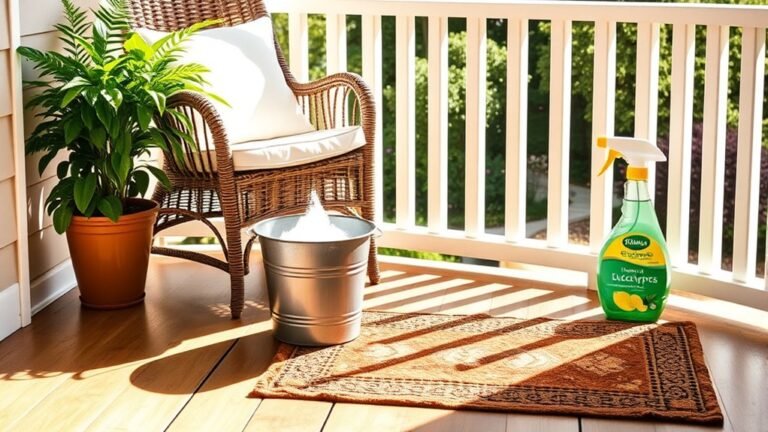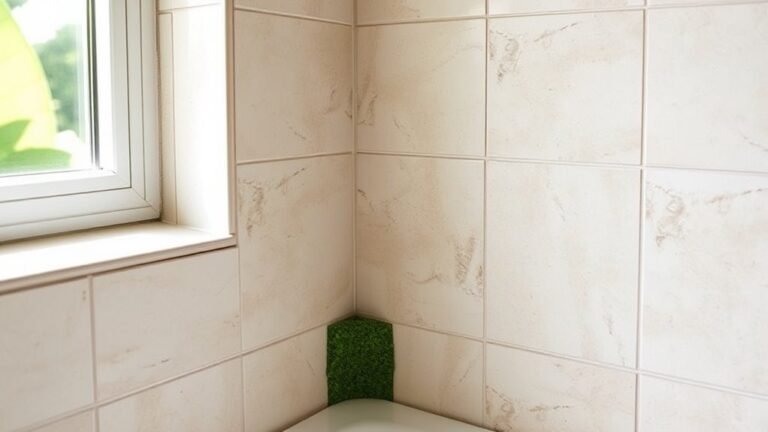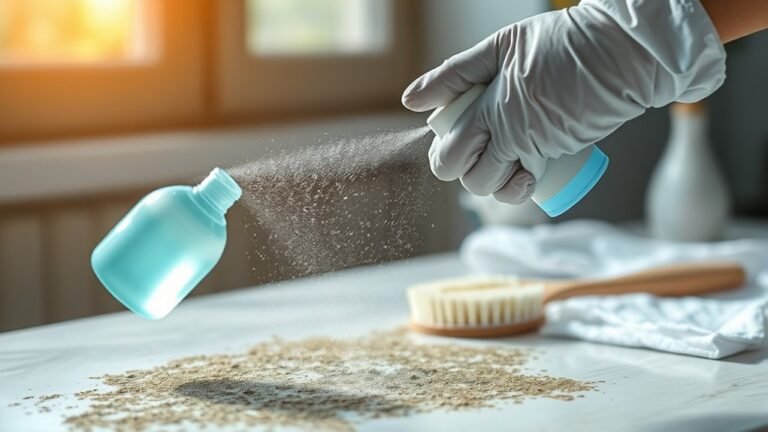How to Clean Your Mattress Safely
To safely clean your mattress, start by removing all bedding and vacuuming thoroughly, focusing on seams. Spot clean stains gently using diluted mild detergent or natural solutions like baking soda paste, testing first on a hidden area. Sprinkle baking soda over the mattress to deodorize, letting it sit several hours before vacuuming. Avoid excess moisture and air out the mattress completely to prevent mold. Finish by protecting it with a cover and scheduling regular cleanings. You’ll find detailed tips to enhance mattress care ahead.
Gather Essential Cleaning Supplies
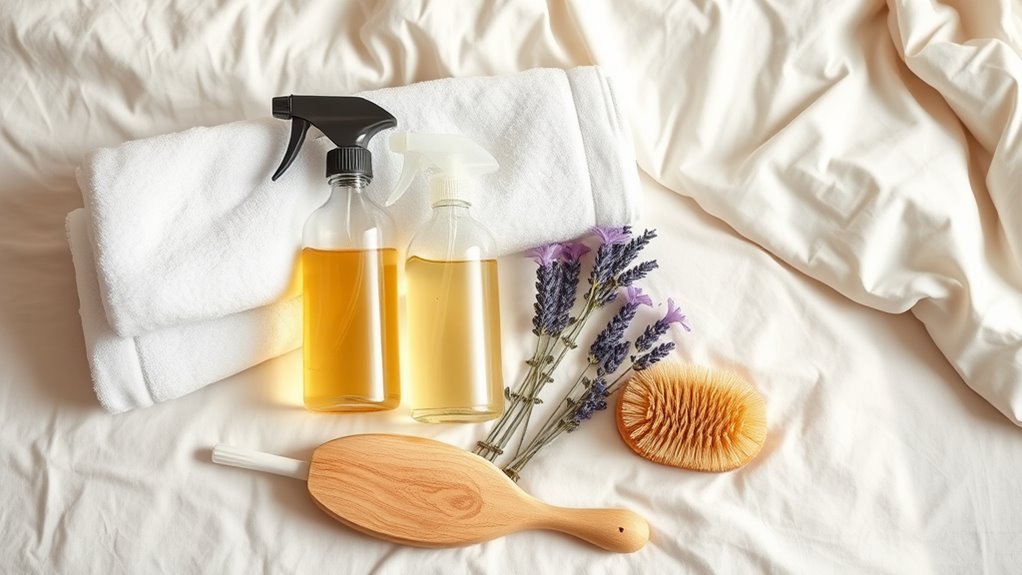
Before you begin cleaning your mattress, you’ll need to gather a few essential supplies to guarantee the process is thorough and effective. First, identify your mattress type—memory foam, innerspring, or latex—since each demands specific care. Collect a vacuum with an upholstery attachment to remove dust and debris. Have a mild detergent or mattress cleaner on hand for spot cleaning stains safely. Baking soda is vital for deodorizing, while a spray bottle lets you apply solutions evenly. Keep clean cloths or microfiber towels ready for blotting. Depending on your mattress type and cleaning frequencies—typically every three to six months—these tools assure you maintain freshness without damage. Preparing properly lets you tackle the job efficiently, giving you the freedom to enjoy a clean, healthy sleeping environment.
Remove Bedding and Vacuum the Mattress
Start by stripping all bedding, including sheets, pillowcases, and mattress protectors, to expose the mattress surface fully. Attach the vacuum’s upholstery tool and methodically run it over the entire mattress, paying close attention to seams and crevices where dust and allergens accumulate. This careful vacuuming prepares your mattress for deeper cleaning steps.
Strip All Bedding
Once you’ve prepared your cleaning supplies, carefully remove all bedding, including sheets, pillowcases, and mattress protectors, to expose the mattress surface fully. Be mindful of your mattress materials, as some fabrics may require gentler handling during cleaning. Stripping the bedding completely allows you to assess the mattress condition and identify any spots needing special attention. Regular cleaning frequency depends on your environment and personal habits, but aim to strip and clean bedding at least once every two weeks to maintain freshness and hygiene. Removing all layers also prevents dirt and allergens from settling back onto the mattress. This methodical approach sets the stage for a thorough mattress clean, giving you the freedom to rest easy in a fresh, healthy sleeping space.
Use Vacuum Attachments
Anyone looking to thoroughly clean their mattress should use vacuum attachments designed for upholstery to remove dust, dirt, and allergens effectively. Start by removing all bedding to gain full access to the mattress surface. Choose a vacuum with specific attachments—such as a crevice tool and brush head—that enhance mattress vacuuming by reaching seams and textured areas. These attachments target embedded particles without damaging the fabric. Methodically run the vacuum over every inch, applying steady pressure and overlapping strokes to guarantee no spots are missed. The attachment benefits include improved suction and gentle cleaning, preserving your mattress integrity. Taking this precise approach not only eliminates allergens but also extends your mattress’s lifespan, giving you the freedom to enjoy a cleaner, healthier sleeping environment.
Focus on Seams
Although you’ve already removed the bedding and vacuumed the mattress surface, it’s crucial to pay close attention to the seams where dust, dirt, and allergens tend to accumulate. Seam care requires targeted seam cleaning to prevent buildup and maintain mattress hygiene. Use a crevice tool or soft brush attachment to reach these narrow areas effectively.
| Step | Tool Needed | Purpose |
|---|---|---|
| 1. Vacuum | Crevice tool | Remove dust and debris |
| 2. Spot clean | Mild detergent | Treat stains in seams |
| 3. Dry | Air circulation | Prevent moisture buildup |
Focusing on seams guarantees your mattress stays fresh and allergen-free, granting you the freedom to sleep soundly.
Spot Clean Stains Using Gentle Solutions
When you spot clean stains, always opt for mild cleaning agents like diluted dish soap or baking soda to avoid damaging the mattress fabric. Before applying any solution broadly, test it on a hidden section to guarantee it won’t cause discoloration or deterioration. This careful approach helps preserve your mattress while effectively tackling stains.
Choose Mild Cleaning Agents
Since harsh chemicals can damage mattress materials and reduce their lifespan, you should opt for mild cleaning agents when spot cleaning stains. Choosing gentle solutions guarantees your mattress stays intact and safe, preserving your freedom to enjoy a clean, comfortable sleeping environment. Consider these natural alternatives and eco-friendly options:
- White vinegar diluted with water, which effectively breaks down stains without harsh residues
- Baking soda paste, a gentle abrasive that lifts dirt and neutralizes odors
- Castile soap mixed with water, providing a safe, biodegradable cleanser
Test on Hidden Area
Before applying any mild cleaning solution to a visible stain, you’ll want to test it on a hidden area of your mattress first. This step helps guarantee your chosen solution won’t damage or discolor the fabric. Start by selecting a small, inconspicuous spot, such as under the mattress edge or beneath the fabric tag. Apply a small amount of your cleaning agent using a clean cloth, and wait at least 15 minutes to observe any reaction. This methodical test method reveals if the solution safely interacts with the material without causing hidden stains or weakening fibers. Only after confirming no adverse effects should you proceed to treat the visible stains. Testing protects your mattress’s integrity and grants you the freedom to clean confidently.
Deodorize With Baking Soda
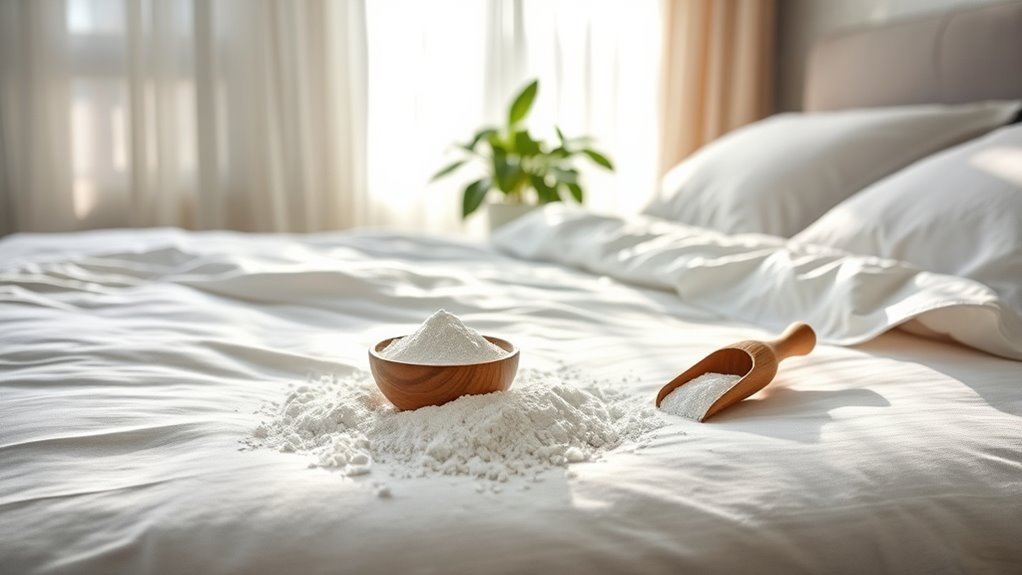
Anyone looking to freshen up their mattress can turn to baking soda, a simple yet effective deodorizer. Baking soda benefits include its ability to absorb moisture and neutralize odors without harsh chemicals, making it a natural deodorizer ideal for maintaining your mattress’s freshness. To deodorize your mattress effectively:
- Liberally sprinkle baking soda over the entire surface, focusing on areas prone to odors.
- Let it sit for several hours, or overnight if possible, allowing the baking soda to absorb unwanted smells.
- Vacuum thoroughly to remove all baking soda residues, ensuring no powder remains trapped in the fabric.
Use a Mild Detergent for Deeper Cleaning
While baking soda does a great job at neutralizing odors, it doesn’t remove stains or deeply embedded dirt. To tackle these, you’ll want to use a mild detergent diluted in water. Choose gentle detergent alternatives like castile soap or plant-based cleaners to avoid harsh chemicals that might damage your mattress or irritate your skin. Apply the solution with a soft cloth, gently dabbing the stained areas without oversaturating the fabric. Afterward, use a clean, damp cloth to remove any residue, then allow the mattress to air dry completely. Maintain a consistent cleaning frequency—ideally every six months or after spills—to keep your mattress fresh and hygienic while preserving your freedom from frequent, intensive cleaning sessions. This method guarantees deeper cleaning without compromising your mattress’s integrity.
Avoid Excess Moisture to Prevent Mold
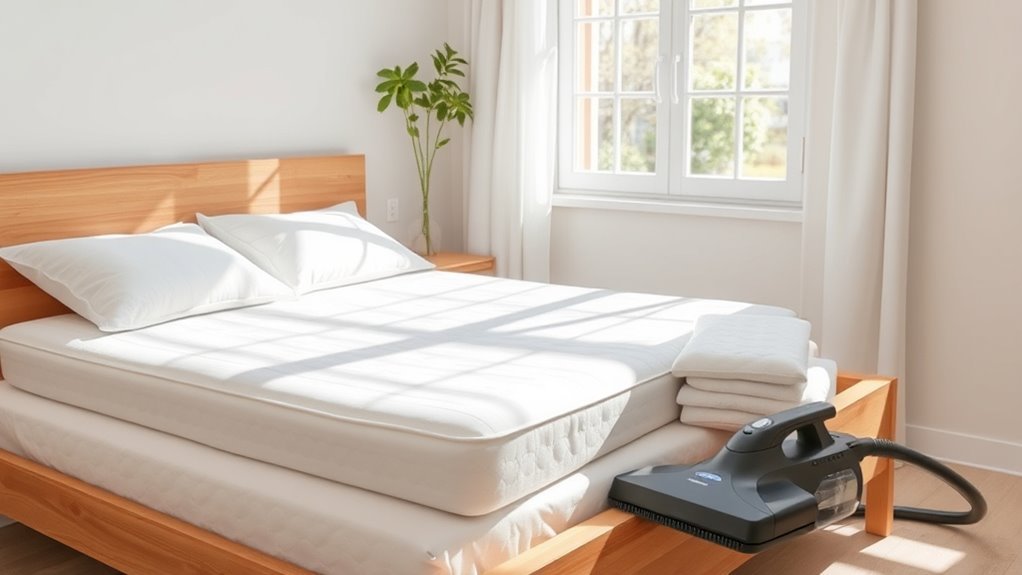
When cleaning your mattress, use as little water as possible to avoid saturating the fabric. After applying any cleaning solution, make sure the mattress dries thoroughly by allowing ample airflow and, if possible, placing it in a well-ventilated area. Proper drying is essential to prevent mold growth and maintain a healthy sleeping environment.
Use Minimal Water
How much water should you use when cleaning your mattress? Just enough to lift stains without soaking the fabric—this balance is key. Excess moisture invites mold, stripping away your freedom to breathe easy. Embrace water conservation techniques and mattress cleaning alternatives like:
- Spot cleaning with a damp cloth to target stains precisely
- Using baking soda or enzyme cleaners that require minimal moisture
- Applying sprays sparingly instead of soaking the mattress
Ensure Proper Drying
Because moisture left in your mattress can quickly lead to mold growth, ensuring thorough drying is essential after any cleaning. Different mattress materials absorb moisture in varying degrees, so understanding your mattress type helps you apply the right drying techniques. For example, memory foam retains water longer than innerspring mattresses, requiring more time and airflow. Start by opening windows or turning on fans to increase air circulation around the mattress. If possible, position the mattress upright to expose both sides to air. Avoid using excessive heat, which can damage certain mattress materials. Dehumidifiers also aid in removing residual moisture. Check regularly for damp spots by pressing your hand firmly; if it feels cool or wet, continue drying. Prioritizing proper drying protects your mattress’s integrity and keeps mold at bay, granting you the freedom of a clean, healthy sleep environment.
Air Out the Mattress Thoroughly
Although it might seem simple, airing out your mattress thoroughly is an essential step in maintaining its freshness and hygiene. Proper mattress ventilation helps eliminate trapped moisture, odors, and allergens, promoting a healthier sleep environment. To achieve ideal air circulation, follow these mattress ventilation tips:
- Remove all bedding and lift the mattress to allow air to flow underneath.
- Position the mattress near an open window or use a fan to enhance airflow.
- Let it air out for several hours, ideally in direct sunlight, which naturally kills bacteria and dust mites.
Protect Your Mattress With a Cover
Since your mattress works hard to provide you with comfort every night, protecting it with a cover is essential to extend its lifespan and maintain cleanliness. You should consider various mattress cover types, such as waterproof, hypoallergenic, and breathable options, each designed to address specific needs. Waterproof covers shield against spills and stains, while hypoallergenic covers prevent dust mites and allergens, enhancing mattress protection. Selecting the right cover not only preserves your mattress’s condition but also supports a healthier sleep environment. Make sure the cover fits snugly to avoid shifting and covers all sides for full protection. By investing in an appropriate mattress cover, you maintain hygiene effortlessly, reduce wear and tear, and enjoy greater freedom to relax, knowing your mattress stays clean and protected over time.
Establish a Regular Cleaning Schedule
Setting a cleaning schedule for your mattress every three to six months helps maintain its hygiene and prolong its lifespan. Consistent mattress maintenance guarantees you enjoy a fresh, comfortable sleeping environment without feeling trapped by dirt or allergens. Establish a cleaning frequency that fits your lifestyle to keep freedom in your routine. Consider these key reasons for regular cleaning:
- Rediscover the freedom of a spotless sleeping surface, free from stains and odors.
- Prevent buildup that could restrict your mattress’s comfort and support.
- Maintain a healthy space that supports restful, uninhibited sleep.
Address Allergens and Dust Mites Effectively
When you tackle allergens and dust mites in your mattress, you’re directly improving the quality of your sleep and overall health. Begin by vacuuming your mattress meticulously using a HEPA-filter vacuum to remove dust mite debris and allergens. Next, apply a mattress-safe allergen reduction spray designed to neutralize dust mite proteins. Encase your mattress and pillows in allergen-proof covers to create a barrier that prevents dust mite infestation. Wash bedding weekly in hot water—at least 130°F—to kill dust mites effectively. Maintain low indoor humidity, ideally below 50%, since dust mites thrive in moist environments. By following these precise steps, you guarantee thorough dust mite prevention while minimizing allergen buildup. This methodical approach grants you the freedom to rest easier, knowing your mattress supports a healthier living space.
Frequently Asked Questions
How Often Should I Replace My Mattress Entirely?
You should replace your mattress every 7 to 10 years, as that’s the typical mattress lifespan. Keep an eye out for replacement signs like sagging, lumps, or discomfort that impacts your sleep quality. If you wake up with aches or allergies worsen, it’s a clear signal. Staying proactive guarantees you enjoy freedom from restless nights and maintain ideal support for your body, so don’t hesitate to upgrade when those signs appear.
Can Mattress Cleaning Reduce Bed Bug Infestations?
Yes, mattress cleaning can help reduce bed bug infestations by improving mattress hygiene, but it’s not a standalone solution. You’ll want to vacuum thoroughly, use mattress encasements, and wash bedding regularly for effective bed bug prevention. Cleaning removes eggs and dirt, limiting their habitat, but you may still need professional treatment if the infestation’s severe. Staying consistent with mattress hygiene gives you more control over your sleeping environment’s freedom.
Is Professional Mattress Cleaning Necessary?
You might wonder if professional mattress cleaning is necessary. While you can maintain mattress hygiene benefits by regular vacuuming and spot cleaning, professionals offer a deeper clean that removes allergens and dust mites efficiently. However, professional cleaning costs can be high, so weigh the benefits against your budget. If you value a truly fresh, allergen-free mattress without hassle, investing in experts can be worth it for your health and freedom from worries.
What Mattress Materials Are Easiest to Clean?
Cleaning a mattress shouldn’t feel like climbing Everest, right? You’ll find memory foam and organic cotton mattresses are among the easiest to clean. Memory foam resists stains better and dries faster, so you can spot-clean without soaking it. Organic cotton covers breathe well, letting you freshen them with gentle vacuuming or mild detergent. Being methodical—treating stains promptly and using minimal moisture—keeps your mattress fresh and free, giving you the freedom to rest easy.
How Do Mattress Cleaners Affect Warranty Coverage?
When you use mattress cleaners, it’s essential to check your mattress warranty terms first. Some cleaning products can void your mattress warranty if they contain harsh chemicals or cause damage. Stick to mild, manufacturer-recommended cleaning products to protect your coverage. Avoid soaking the mattress or using abrasive substances. By following these guidelines, you’ll maintain your warranty’s validity while keeping your mattress clean, giving you the freedom to care for it safely and effectively.
